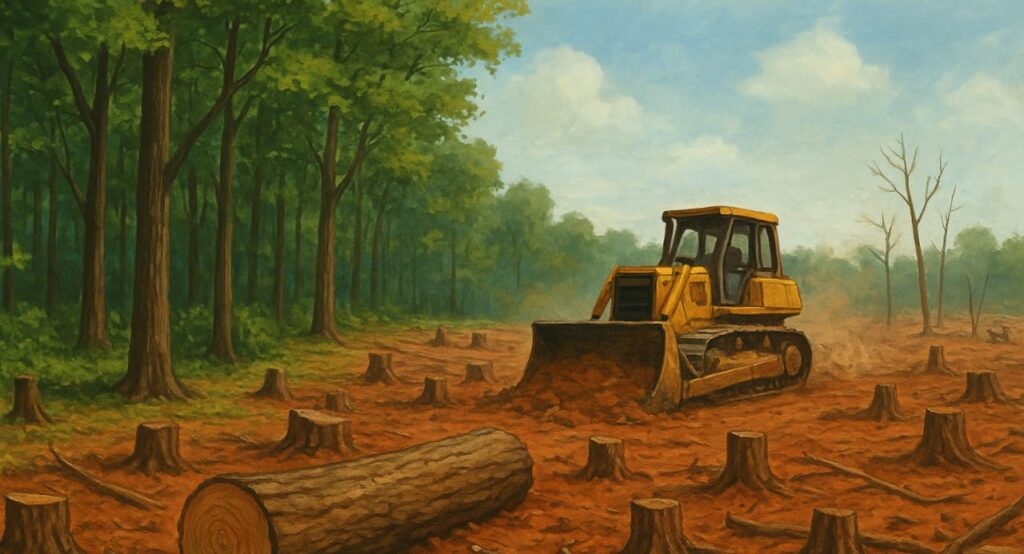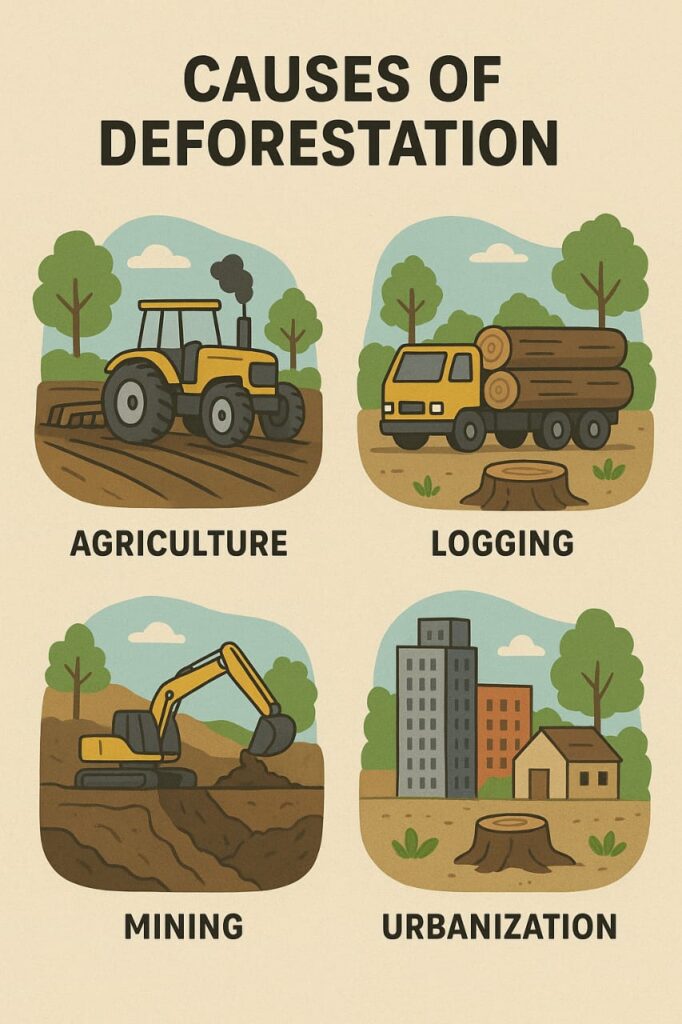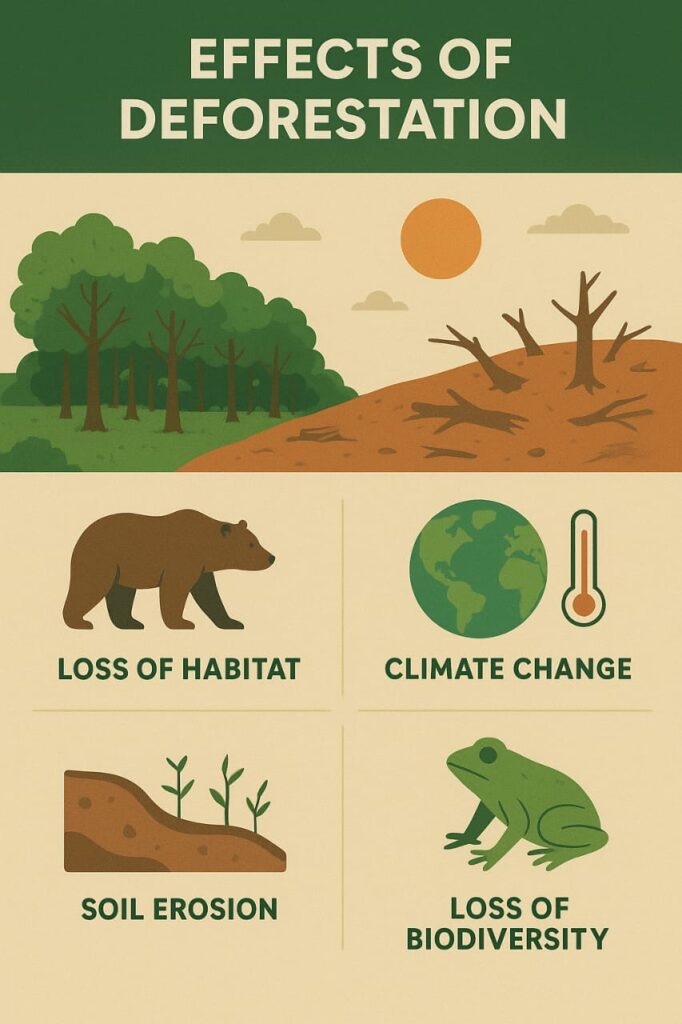Deforestation means the permanent cutting down or clearing of forests for various human activities. It is one of the most serious environmental problems on our planet. Forests are like the lungs of the Earth — they absorb carbon dioxide, release oxygen, and provide homes to countless species of plants and animals. Sadly, humans have been clearing forests for agriculture, construction, mining, and other activities, leading to severe damage to nature and biodiversity.

According to the World Wildlife Fund (WWF), forests cover about 30% of the Earth’s land area. But every year, millions of hectares of forests are lost due to deforestation. This destruction not only affects wildlife but also contributes to global warming and climate change.
Types of Deforestation
There are mainly two types of deforestation:
1. Clear-Cutting
In this method, almost all trees in an area are cut down at once. This practice is mainly used for commercial purposes like timber or agriculture. It destroys the ecosystem completely and leaves the land barren.
2. Selective Logging
In selective logging, only certain trees are cut down based on their type or commercial value. While it seems less harmful, it still damages the forest structure and disturbs the natural balance.
Causes of Deforestation
Deforestation occurs for many reasons, both natural and human-made. However, human activities are the major cause behind the rapid loss of forests worldwide.
1. Agricultural Expansion
The biggest reason for deforestation is the conversion of forests into farmland or pastures. Farmers cut trees to grow crops and raise livestock. According to the Food and Agriculture Organization (FAO), about 80% of global deforestation happens due to agricultural expansion.

2. Urbanization and Construction
With the growth of population and cities, land is needed for building houses, roads, industries, and infrastructure. Trees are cut down to make way for these projects, leading to permanent forest loss.
3. Logging
Logging means cutting trees for wood and timber. Wood is used for making furniture, paper, and fuel. Illegal logging, in particular, causes severe damage as it often happens without any replanting.
4. Mining
Mining for minerals and metals often takes place in forest areas. It not only removes trees but also pollutes the soil and nearby water sources.
5. Overpopulation
As the population grows, the demand for food, water, and shelter also increases. This forces humans to clear more land for agriculture and housing, putting extra pressure on forests.
6. Overgrazing
Allowing livestock to graze too much in forest areas damages the vegetation. Over time, it makes the land barren and increases soil erosion.
7. Climate Change and Natural Factors
Natural causes like forest fires, storms, and pests also lead to deforestation. But in recent years, human-induced climate change has increased the frequency and intensity of such events, making the situation worse.
Read more Afforestation
Effects of Deforestation
Deforestation has several harmful effects on the environment, wildlife, and human life. Let’s look at the major consequences.
1. Loss of Biodiversity
Forests are home to about 80% of the world’s land-based species. When trees are cut down, animals lose their homes, and many species face extinction. For example, animals like orangutans, tigers, and elephants are endangered mainly because of habitat loss.

2. Soil Erosion and Flooding
Tree roots help hold the soil together. When trees are removed, the soil becomes loose and easily washed away by rain, leading to soil erosion and frequent floods.
3. Climate Change
Trees absorb carbon dioxide (CO₂) and release oxygen. When people cut down or burn them, they release the stored CO₂ into the atmosphere, increasing greenhouse gases and contributing to global warming.
4. Disruption of the Water Cycle
Forests play a key role in maintaining rainfall and the water cycle. Without trees, there is less evaporation and less rainfall, which leads to droughts and reduced agricultural productivity.
5. Impact on Local Communities
Many rural people depend on forests for food, fuel, and livelihood. Deforestation destroys their source of income and makes them vulnerable to poverty and hunger.
6. Food Insecurity
As fertile soil is lost and the climate changes, farmers find it difficult to produce food.In the long term, this can lead to food shortages and economic instability.
Animals Affected by Deforestation
Deforestation has a direct impact on wildlife. Forests are natural shelters for millions of species. When forests disappear, so do the animals that live there.
Some of the animals most affected include: Orangutans, Sumatran tigers, Elephants, Philippine tarsiers, and various bird and insect species.
These animals are often unable to migrate or adapt to new habitats, which increases their risk of extinction.
Solutions to Deforestation
While deforestation is a serious issue, there are many ways we can work together to reduce it and protect our forests.
1. Reforestation and Afforestation
Planting trees in deforested areas (reforestation) and creating new forests (afforestation) are the most direct ways to restore greenery.
2. Sustainable Agriculture
Farmers can use modern farming methods that require less land and reduce the need to cut down forests.
3. Go Paperless and Use Recycled Products
Reducing paper use and recycling can lower the demand for timber.
4. Government Laws and Regulations
Governments should enforce strict laws against illegal logging and promote conservation programs.
5. Support Eco-Friendly Companies
Consumers should buy products from companies that follow sustainable practices.
6. Community Participation
Forest management and awareness campaigns should involve local communities.
7. Green Business Practices
Businesses can adopt eco-friendly operations by reducing waste and supporting reforestation.
What Is Being Done to Stop Deforestation?
Many organizations and governments are taking steps to control deforestation. Programs like REDD+ by the United Nations, eco-forestry projects, and global replanting campaigns are examples of positive efforts.
Conclusion
Deforestation is not just an environmental issue—it’s a global crisis that affects life, climate, and future generations. Human greed and carelessness have led to the destruction of forests, which are vital for our survival. To save our planet, every individual must take responsibility. Forests are our natural wealth — once we destroy them, we cannot bring them back easily. Protecting forests today means ensuring a safer, greener, and healthier world for tomorrow.
Read more Atmosphere
